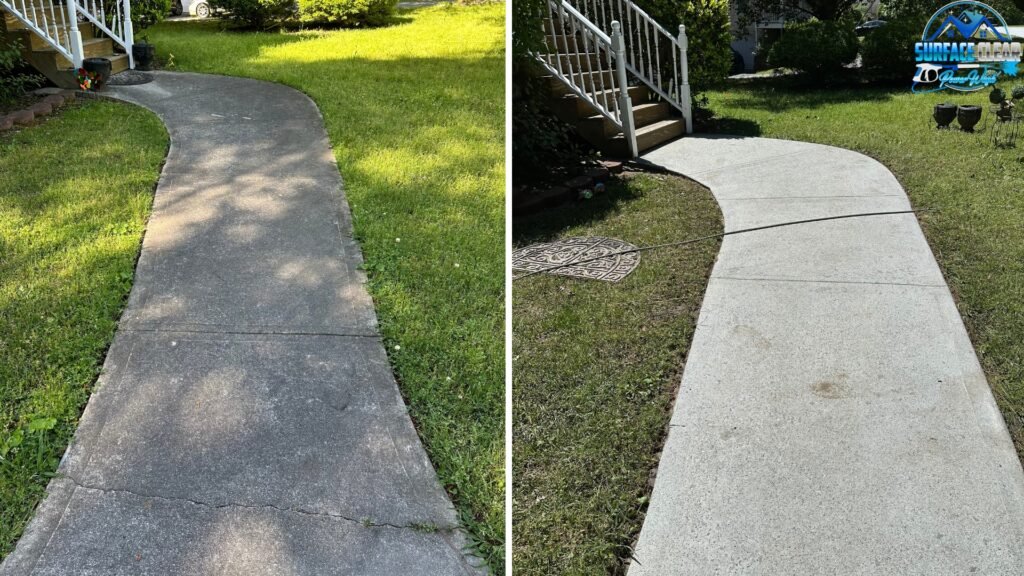Welcome to the definitive guide on pressure washing surfaces! Whether you’re a seasoned professional or just getting started with your pressure washing business, mastering the art of cleaning various surfaces is essential for success. In this comprehensive guide, we’ll cover everything you need to know about pressure washing different surfaces effectively and safely.

Why Pressure Washing?
Pressure washing is a highly effective cleaning method that utilizes high-pressure water spray to remove dirt, grime, mold, mildew, and other contaminants from surfaces. It’s a fast and efficient way to enhance the appearance of driveways, sidewalks, decks, siding, and more.
Safety First
Before we dive into specific surfaces, let’s talk safety. Pressure washers are powerful tools that can cause injury or damage if not used correctly. Always wear protective gear, including safety goggles, closed-toe shoes, and gloves. Be mindful of your surroundings and avoid spraying water near electrical outlets or fixtures.
Choosing the Right Equipment
Selecting the appropriate pressure washer and nozzles is crucial for achieving optimal results without causing damage. For most residential applications, a medium-duty electric pressure washer (1500-2500 PSI) is sufficient. Commercial jobs may require heavy-duty gas-powered models (2500+ PSI). Use a variety of nozzles for different cleaning tasks—0-degree for tough stains, 25-degree for general cleaning, and 40-degree for delicate surfaces.
Surface-Specific Techniques
1. Driveways and Sidewalks
- Clear debris and weeds from cracks.
- Apply detergent and let it sit before rinsing.
- Use a 25-degree nozzle at a low angle to avoid damage.
2. Decks and Wooden Surfaces
- Use low pressure (under 1500 PSI) to prevent damage to wood.
- Keep the nozzle moving to avoid gouging the surface.
3. Siding and Brick
- Start from the bottom and work your way up to prevent streaks.
- Use a wider nozzle angle (25-40 degrees) to avoid damage.
4. Concrete and Masonry
- Use a rotary scrub brush for deep cleaning.
- Avoid using high pressure near edges to prevent chipping.
5. Vehicles
- Use a gentle soap and low-pressure nozzle to avoid paint damage.
- Keep a safe distance to prevent accidental dents or scratches.
Best Practices for Pressure Washing
- Always test a small inconspicuous area first.
- Maintain a nozzle distance of 6-12 inches from the surface.
- Work systematically to ensure complete coverage.
- Rinse thoroughly after applying detergents.
- Consider environmental impact—use biodegradable cleaners when possible.
Maintenance Tips for Your Pressure Washer
Regular maintenance of your pressure washer is essential for optimal performance and longevity:
- Flush out detergent tanks and hoses after each use.
- Check and replace worn-out nozzles or seals.
- Store in a dry, protected area away from freezing temperatures.
Conclusion
Mastering the art of pressure washing various surfaces requires practice, patience, and attention to detail. By following the techniques outlined in this guide and prioritizing safety, you’ll be well-equipped to tackle any cleaning job effectively and efficiently. Remember, a clean surface is a happy surface!
Ready to get started or have more questions? Contact us today to learn more about our pressure washing services or to schedule a consultation. Happy cleaning!
For expert pressure washing services in Snellville, GA, contact Surface Clear Power Wash at 678-577-1062 or visit www.surfaceclearpowerwash.com . We’re here to help you achieve a spotless clean!
